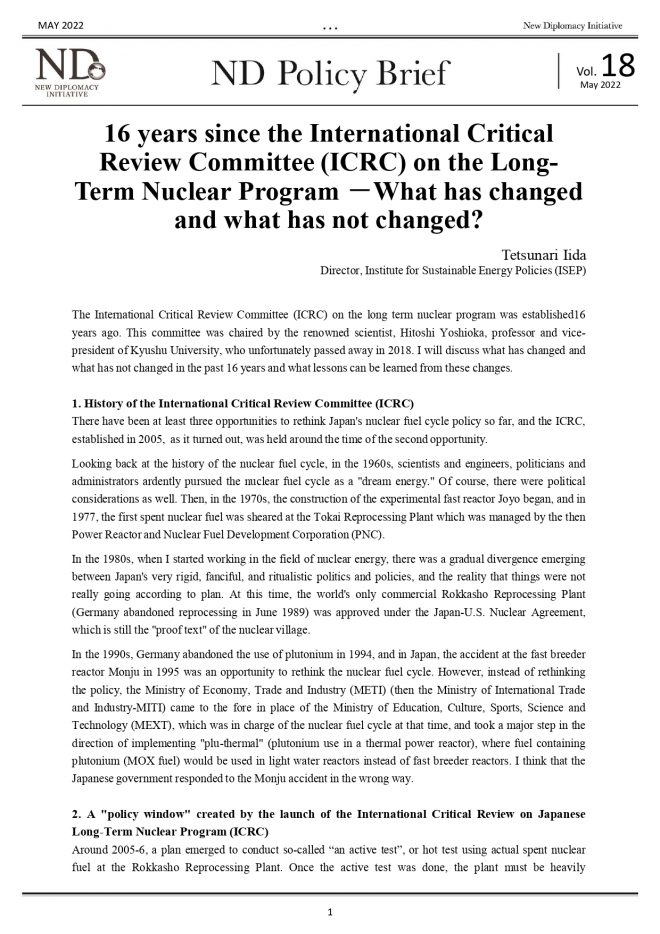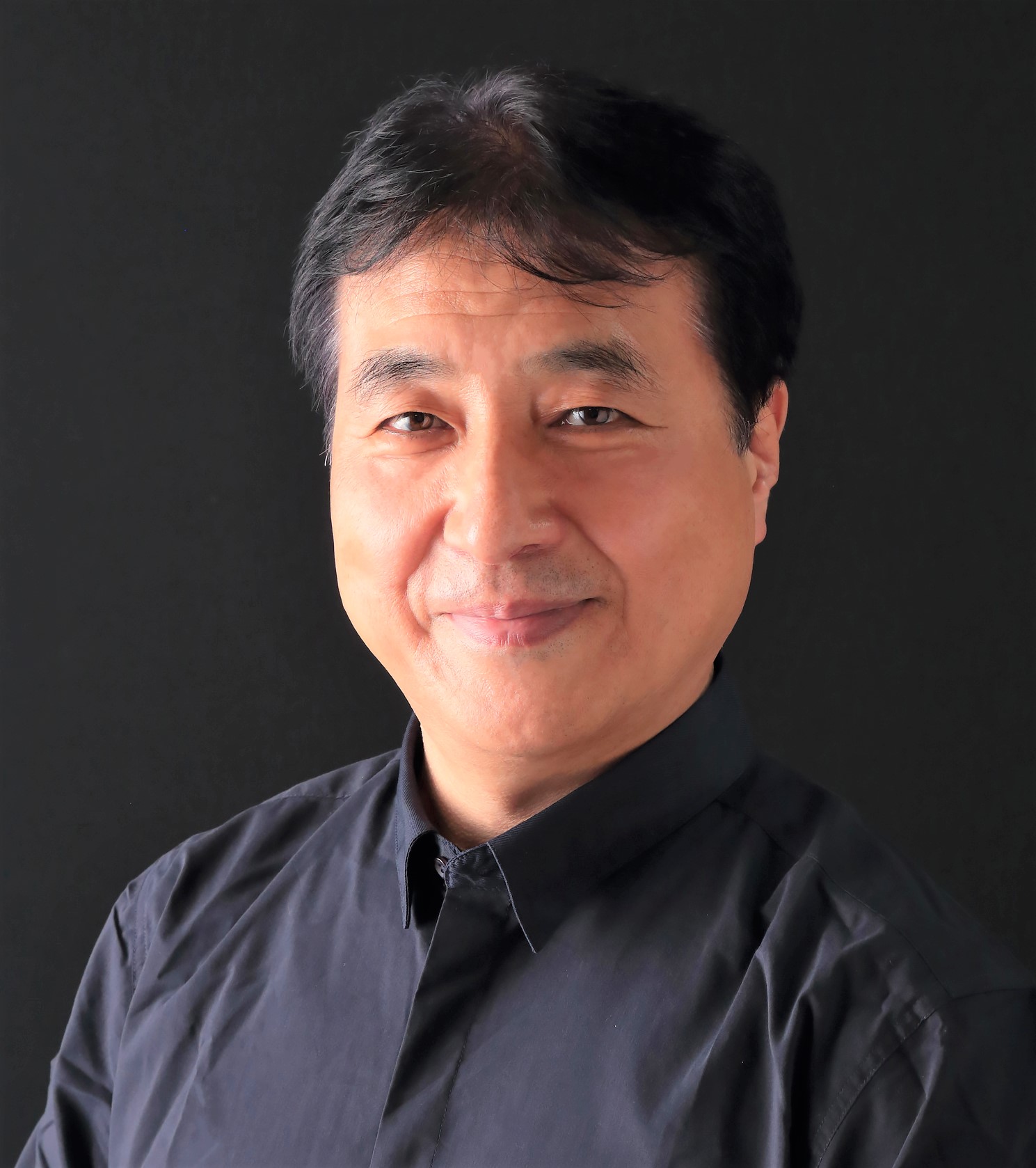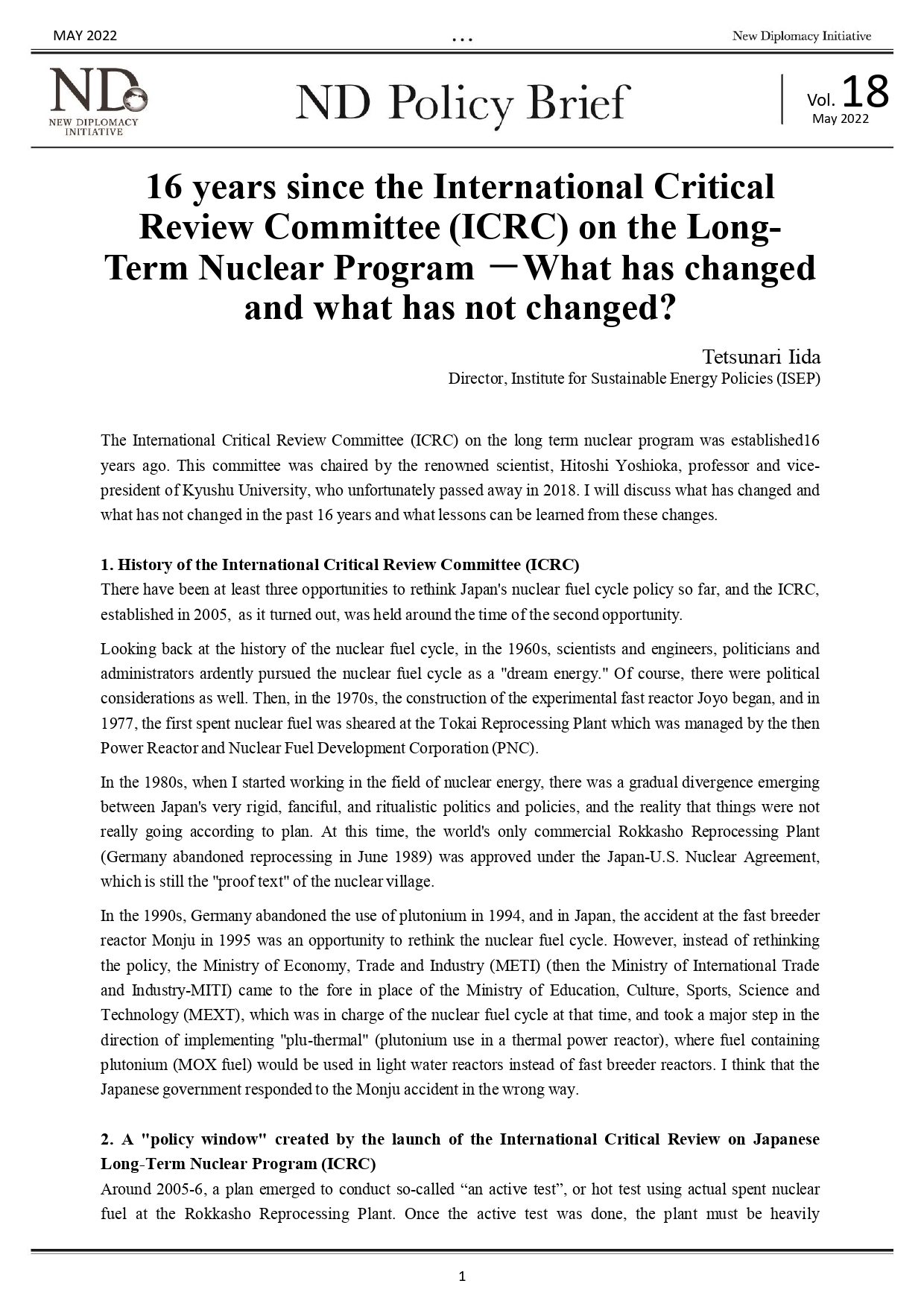Tetsunari Iida
Director, Institute for Sustainable Energy Policies (ISEP)
The International Critical Review Committee (ICRC) on the long term nuclear program was established16 years ago. This committee was chaired by the renowned scientist, Hitoshi Yoshioka, professor and vice-president of Kyushu University, who unfortunately passed away in 2018. I will discuss what has changed and what has not changed in the past 16 years and what lessons can be learned from these changes.
1.History of the International Critical Review Committee (ICRC)
There have been at least three opportunities to rethink Japan’s nuclear fuel cycle policy so far, and the ICRC, established in 2005, as it turned out, was held around the time of the second opportunity.
Looking back at the history of the nuclear fuel cycle, in the 1960s, scientists and engineers, politicians and administrators ardently pursued the nuclear fuel cycle as a “dream energy.” Of course, there were political considerations as well. Then, in the 1970s, the construction of the experimental fast reactor Joyo began, and in 1977, the first spent nuclear fuel was sheared at the Tokai Reprocessing Plant which was managed by the then Power Reactor and Nuclear Fuel Development Corporation (PNC).
In the 1980s, when I started working in the field of nuclear energy, there was a gradual divergence emerging between Japan’s very rigid, fanciful, and ritualistic politics and policies, and the reality that things were not really going according to plan. At this time, the world’s only commercial Rokkasho Reprocessing Plant (Germany abandoned reprocessing in June 1989) was approved under the Japan-U.S. Nuclear Agreement, which is still the “proof text” of the nuclear village.
In the 1990s, Germany abandoned the use of plutonium in 1994, and in Japan, the accident at the fast breeder reactor Monju in 1995 was an opportunity to rethink the nuclear fuel cycle. However, instead of rethinking the policy, the Ministry of Economy, Trade and Industry (METI) (then the Ministry of International Trade and Industry-MITI) came to the fore in place of the Ministry of Education, Culture, Sports, Science and Technology (MEXT), which was in charge of the nuclear fuel cycle at that time, and took a major step in the direction of implementing “plu-thermal” (plutonium use in a thermal power reactor), where fuel containing plutonium (MOX fuel) would be used in light water reactors instead of fast breeder reactors. I think that the Japanese government responded to the Monju accident in the wrong way.
2. A “policy window” created by the launch of the International Critical Review on Japanese Long-Term Nuclear Program (ICRC)
Around 2005-6, a plan emerged to conduct so-called “an active test”, or hot test using actual spent nuclear fuel at the Rokkasho Reprocessing Plant. Once the active test was done, the plant must be heavily contaminated, then, its decommissioning must become very much difficult and expensive, so there was a growing political momentum that if the reprocessing plant was going to be stopped, it should be stopped before the active test.
As I later found out, Mr. Seiji Murata, then vice-minister of METI, thought it would be better to stop the plant and gave instructions privately to the Nuclear Energy Policy Division to consider ways to stop it around 2003. At the same time, Mr. Tsunehisa Katsumata, the president of TEPCO, was also looking for a way to stop the Rokkasho reprocessing plant after he became president in 2002. Then, in January 2004, I gave a lecture at the “Taro Juku,” led by Taro Kono, a Liberal Democratic Party Member of Parliament, in which I talked about the need to reconsider the reprocessing nuclear fuel cycle before considering the pros and cons of nuclear power. Mr. Kono agreed and started to send out information calling for reconsideration of the Rokkasho Reprocessing Plant.
At the beginning of 2004, these three streams merged and rose to a point where the so-called “policy window” opened wide, and the momentum for a review of the nuclear fuel cycle grew, but as it turned out, no review was made. In June of the same year, a new committee on the formulation of a new nuclear energy plan was launched under the Atomic Energy Commission, and the majority of the committee was proponents, who discussed the continuation of reprocessing all the spent fuel as in the past. The following year, in October 2005, the ” New Nuclear Policy-Planning Council’s Interim Report” was compiled.
It was at this time that Dr. Hitoshi Yoshioka and I started working with the Takagi Foundation to submit the New Nuclear Policy-Planning Council’s Interim Report to an international review. The then Governor of Fukushima Prefecture, Eisaku Sato, was also working to reconsider the nuclear fuel cycle and pluthermal power generation, and Governor Sato, Dr. Hitoshi Yoshioka and I worked closely together.
The third opportunity for a rethink was right after the Fukushima nuclear accident. This accident caused a political and policy catastrophe, and this was the greatest opportunity to rethink the nuclear fuel cycle, but in a sense, we failed to do so because we pushed the wrong button. This will be discussed later.
3. METI and TEPCO at cross purposes over Rokkasho Reprocessing Plant
As I mentioned earlier, the opportunity for rethinking the nuclear fuel cycle policy started in 2004, before the Rokkasho reprocessing plant was contaminated by the active tests. The timing of the ICRC in 2005 coincided with the review of the Framework for Nuclear Energy Policy, and METI and TEPCO also wanted a review of the reprocessing policy, although their ideas were somewhat divergent. So the 2005 ICRC was held at that time.
Meanwhile, at METI, Vice-Minister Seiji Murata, who was scheduled to retire in June 2004, temporarily transferred Mr.Masaya Yasui, then Director of the Nuclear Energy Policy Division, just before he left his post. This was because Mr. Yasui, against the will of Vice-Minister Murata, discouraged TEPCO’s efforts to reconsider the nuclear fuel cycle and, on the contrary, steered the company toward continuing reprocessing. However, his successor, Mr. Tadao Yanase, who later became famous for his role in the Morimoto and Kake Gakuen scandals involving Prime Minister Abe, sought out the culprits in the Nuclear Energy Policy Division who were working to stop reprocessing policy rethink and removed or transferred all of them, thus ending METI’s revolt against the Rokkasho Reprocessing Plant review. The stage had now shifted to the Atomic Energy Commission’s review of the policy guidelines, where the proponents of the nuclear fuel cycle policy had been in the majority from the beginning, so there could be no “revolt” this time.
On the other hand, JNFL, which operates the nuclear fuel cycle facility in Rokkasho Village, was in financial trouble due to continuous losses and needed an excuse to withdraw funds from the reprocessing contract fees paid in advance by the power companies. Eventually, on March 27, 2006, the then governor of Saga Prefecture, Mr. Furukawa, gave his approval for pluthermal power generation for the Genkai nuclear power plant in Saga Prefecture, and four days later, on March 31, 2006, the spent fuel stored in the reprocessing facility was moved in order to start active testing. Simply moving this fuel to a different site within Rokkasho meant that JNFL could log a sale of tens of billions of yen on March 31, the last day of the fiscal year, making them profitable. I think this can only be called cheating.
4. Overview of the ICRC panel
I would not explain the details of the ICRC report now, instead briefly introduce it. The New Nuclear Policy-Planning Council’s Interim Report at the time evaluated four scenarios for the nuclear fuel cycle: continued full reprocessing, a combination of direct disposal and reprocessing, direct disposal only, and a reprocessing pause (moratorium). Assessment was made based on 10 points and the conclusion was that continued full reprocessing would be the most beneficial. However, in retrospect, it was a rather forced and contrived argument.
So the following year, 2005, we conducted an international evaluation review of the interim report. As well as being a committee member, I worked as the secretary for the ICRC, with the Takagi Foundation giving administrative backup. International committee members were: Professor Frank von Hippel of the United States, Mr. Fred Parker of the United Kingdom, Mr. Christian Küpper and Mr. Mycle Schneider of Germany. Japanese committee members were Prof. Hitoshi Yoshioka, Attorney Yuichi Kaido, Dr. Takeo Kikkawa, and Mr. Yo Fujimura. Dr. Kikkawa had been a relatively enthusiastic proponent of nuclear power since that time, but he was recommended and introduced by Prof. Yoshioka, who wanted to include a proponent. We also worked closely with MP Taro Kono and the Fukushima Governor Eisaku Sato.
In 2004, Prof. Yoshioka, who was a member of the Atomic Energy Commission, proposed the idea of the ICRC at the New Nuclear Policy-Planning Council meeting, and the Takagi Foundation started preparations in the spring of 2005. In the fall of 2005, we had an international symposium on the nuclear fuel cycle hosted by Fukushima Prefecture in Tokyo, which was quite groundbreaking. Dr. Uchiyama from Tsukuba University who was a member of the Policy-Planning Council at the time, and Governor Eisaku Sato were also present. In the same month, Dr. Yoshioka made a report at the Atomic Energy Commission, and at the end of the month, briefing sessions were held in Karatsu City in Saga Prefecture and in Aomori Prefecture. The following year, in March 2006, Saga Prefecture agreed to pluthermal power generation.
The content of the ICRC review of the four scenarios in the New Nuclear Policy-Planning Council’s Interim Report, was groundbreaking in that it was the first international and scientific policy review of Japan’s nuclear policy documents in almost real time, albeit with some delays. Our review pointed out that reprocessing was a completely fixed policy option from the beginning, and that more realistic policy options should be proposed. It was also pointed out that the “cost of policy change” is an unrealistic assumption and nonsense. It was also pointed out that nuclear proliferation, safety, and uncertainty risks were almost completely ignored, that the policy flexibility proposed in the moratorium was completely disregarded, and that the assessment that continued reprocessing would be the most beneficial in many ways was very dogmatic.
The ICRC report is still available on the Takagi Foundation’s website. It directly points out the obvious logical fallacies and contradictions, and suggests that Japan’s nuclear policy should be reviewed by a fair and reliable independent committee in the future too.
5. Lessons for the future suggested by the ICRC
Unfortunately, real-world politics was completely contrary to the ICRC’s recommendations and policies raced out of control in the opposite direction. When Mr. Yanase took over as Director of the Nuclear Energy Policy Division, the first Shinzo Abe administration accelerated the promotion of nuclear energy, including the Nuclear Nation Project. Toshiba’s acquisition of Westinghouse also took place around this time, and as a result, Toshiba almost went bankrupt 10 years later. It was around this time that nuclear power proceeded full speed ahead, seemingly unstoppable, and policies deteriorated rapidly.
Then the TEPCO Fukushima Daiichi accident happened. In the aftermath of this devastating accident, only nine nuclear power plants in Japan have been approved for restart of the 54 which were operating before March 2011. Some of these have been halted due to various reasons such as failure to meet deadlines to complete countermeasures in case of severe accident. Last year, the share of nuclear power supply was 6 or 7%. Nuclear power is no longer the “core power source” that it once was, and the public consciousness throughout Japan overwhelmingly rejects nuclear power.
Another unfortunate was a “failure” under the former Democratic Party of Japan (DJP) administration. As a step-by-step approach to nuclear energy policy, we should have made the decision to end the nuclear fuel cycle, reprocessing, and plutonium before we decided to quit nuclear energy. This was the case in Sweden and Germany. In Japan, however, the Fukushima nuclear accident occurred before the public had a chance to fully discuss this issue of reprocessing. Although there is a consensus among the Japanese people to reduce the number of nuclear power plants to zero, the debate on the nuclear fuel cycle has been largely left behind.
On the one hand, politicians do not have much knowledge of the situation, and on the other hand, it is quite clear that the electric power and nuclear mafia have been working behind the scenes in Aomori Prefecture and Rokkasho Village. At the time of the DJP administration, an announcement was made by the British nuclear fuel company (BNFL) that they would return reprocessed waste from the UK to Japan, and Rokkasho responded by saying that they would not accept nuclear waste if the government stopped reprocessing. It is clear that the DPJ government was forced into a double bind. As a result, the DPJ government decided to go ahead with zero nuclear power plants, even though it had no choice but to continue reprocessing. In other words, we made a mistake in the policy change procedure. At the time, there were very few experts in the LDP and DPJ administrations who were knowledgeable about nuclear phase-out policies, so the practical solution of interim storage was not well understood. Looking back now, I regret that.
6. Consensus on quitting the nuclear fuel cycle is the first step
Japan needs to get out of the nuclear fuel cycle and get out of nuclear power at the same time, but how to stop the nuclear fuel cycle and nuclear power? The logic of phasing out nuclear power is quite strong, but the logic and consensus on how to stop plutonium and the nuclear fuel cycle is lagging behind. I think we need to work on that as soon as possible.
In the meantime, renewable energy has advanced so rapidly that the nuclear fuel cycle as an alternative energy source is no longer relevant. Now all we have to do is to abandon the military purpose. Figure 1 (see PDF ) shows the cost trends of solar and wind power. Solar power has dropped to one tenth of its previous cost during this period, and wind power has dropped to three tenths or 70% of its cost, and these two are now the cheapest energy sources and are increasing at a tremendous rate. At the recent COP26, some people are still talking about nuclear power, but most of the future scenarios issued by research institutes around the world are shifting to a scenario of 100% renewable energy, especially solar and wind.
On the other hand, the nuclear fuel cycle is becoming increasingly unrealistic. The latest government documents show a totally unrealistic direction. I think the ICRC’s point of view from 16 years ago is still very valid, but the contradictions and mistakes are getting more and more amplified, suggesting the need to seriously reconsider this policy is very urgent. Since the nuclear fuel cycle is being continued on the basis of pure fabrications, we need to reexamine the methodology from an independent standpoint and from the ground up. However, the lesson learned last time is that we were a little late for the “policy window,” so it is better to prepare early. It is better to prepare early for the specific things that should be done when that policy review opportunity comes up.
The nuclear fuel cycle is the most absurd policy in Japan’s ineffective policy system. Indeed the quality of Japan’s policies has deteriorated considerably, whether it is dealing with COVID-19, decarbonization, or renewable energy, so it may be very difficult to rebuild without a deeper review of the system and processes.
Note:
(1) “International Critical Review Committee on the Long Term Nuclear Program” Takagi Foundation.
http://www.takagifund.org/activity/icrc/report/icrcreport2005.pdf
※This paper is based on the author’s presentation at the international symposium “Growing Plutonium Stockpiles and the Rokkasho Reprocessing Plant: Reality of Nuclear Fuel Cycle and Security in East Asia” , Dec. 18-19, 2021. The views expressed here are those of the author.
※This project is supported by a grant from “act beyond trust” (abt) .




